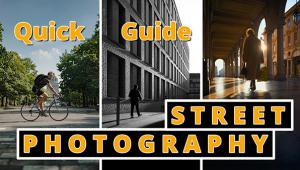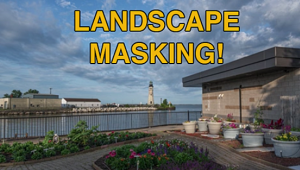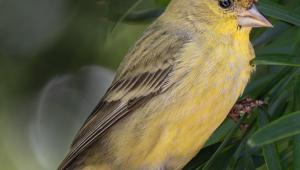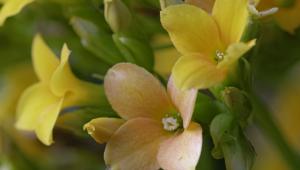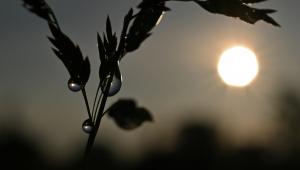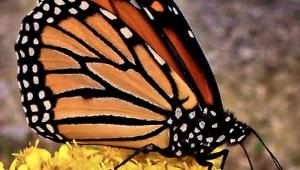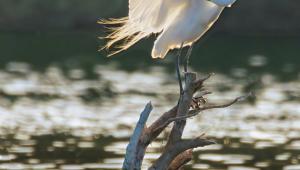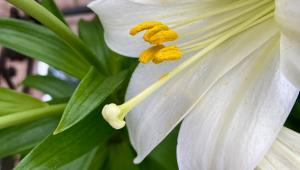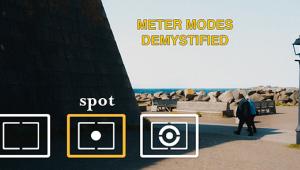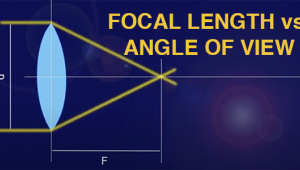How to Capture Great Landscape Photos with Long Lenses

All Photos © David Shaw
My wide-angle lens was perfect when the late-evening shadows crept across the mountains of the Arctic National Wildlife Refuge. The sweeping landscape, wide open and treeless, was suited to the wide field of view. Until, that is, the weather turned, and with it, my perspective on that wild place. I woke one morning to rain pattering intermittently on the nylon of my tent. Between showers, I emerged to find the mountains obscured by scudding clouds. The upper slopes, when visible, were splotched with fresh snow. Patches of sun broke through periodically, tossing yellow light across the green tundra and wildflowers of the valley floor.
A splash of light on a distant peak made me reach for my telephoto. It was a Canon 100-400mm, a lens I’d brought primarily for wildlife. I zoomed in and out, and watched the field of view narrow and expand. Through the long glass I could focus on the elegant details: clouds rolling past a rocky outcrop, slopes of green tundra, even wildflowers with a backdrop of the river’s brown water. When I focused on the foreground, the depth of field compressed, allowing only a narrow sliver of the scene to fall into focus. The stormy day became a playground; the long glass a new door on landscape photography.
Telephotos are surprising tools for photographing the landscape. Broadening the field of view with an increasingly wide angle will have profound effects on the image, so too does narrowing it with a telephoto. Each focal length has advantages and challenges. Here are my thoughts on shooting landscapes at different telephoto lengths.

70-100mm
Just a step above the “normal” lens lies the short telephotos. Many frequently used zooms, such as my much-used and loved Canon 24-105mm L include focal lengths that fall into this category. Since images made in this range are not much above a standard lens, they share many of the same characteristics. Substantial depth of field remains, even at fairly wide apertures, and the field of view is wide enough to include large features of the landscape, such as entire mountains, or broad bends of a river.
While holding on to some of the advantages of a wide-angle or standard lens, short telephotos also retain some of the challenges. This range is not for landscape details alone, rather substantial elements of sky or foreground are often included, reminiscent of classic landscape composition. As in a wide-angle landscape, you must consider the many different layers of an image (foreground, mid-ground, background, subject, etc.). Unlike a wide shot, however, depth of field is compressed, so when possible, use a high f/stop.
Think of this range as a tool to simplify your composition, but that doesn’t mean it’s easy to make an image work.

100-200mm
As I was paging through my Lightroom catalog looking for images to accompany this article, I was surprised to find that this range of focal lengths (100-200mm) is actually one of my most used. I expected to find a lot of portraits and action shots, but was surprised to see how many landscapes appeared when I filtered them out. In fact, some of my very favorite images appeared on my screen.
A couple of years ago, I was hiking with a group of clients on a remote mountainside in far northwestern Alaska. It was late autumn, my last trip of the season, and the tundra below was a mosaic of red, yellow, and orange. We’d summited a small peak and were on our way down when ominous clouds appeared on the far side of the valley. From the way the precipitation blew, I could tell that those clouds held not rain, but snow, and a lot of it.
My mind went into two directions at once. The guide in me, safety oriented and risk-averse, told me I needed to get down with my clients, and fast. We still had a couple thousand feet of descending, plus three or four miles to walk to reach the safety of camp. The photographer in me, however, wanted to drop my pack, pull out the camera, and go to work. I compromised, pausing regularly to shoot as we made our careful way down. I relied heavily on a midrange telephoto, reaching out with my lens to find the patterns in the tundra, the rolling storm, the sweep of the river.
Too long to show a broad field of view, I isolated the components that told the story. I ignored the foreground, cropping it, in camera, completely out of the composition. From my perch high above the river, everything in the frame was far away, maximizing depth of field and relieving any necessity to choose a focal point. And that is where this range of telephotos often succeed: distant landscape elements can be shown in context, sharp from front to back.
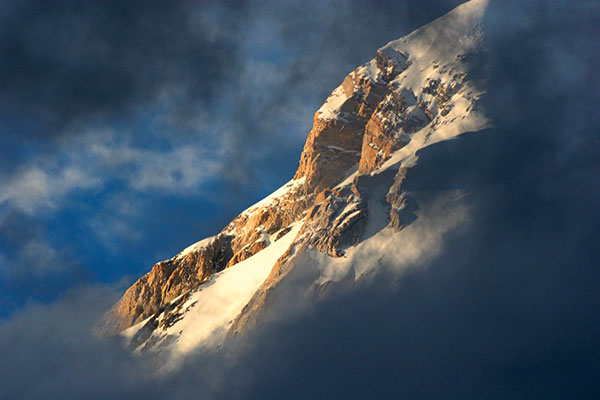
200-400mm
High in the Himalayas of Bhutan, I rose before daybreak and walked a quarter mile to a mid-valley hillock. At 15,000 feet even that small exertion winded me. I recovered, gasping, and watched a dense bank of fog roll past in the gray light. As morning dawned, the fog began to break, alternately revealing and hiding narrow views of the surrounding peaks. The rocks and glaciers of the mountains high above the fog layer were lit by bright morning sun, while I shivered in damp mist.
Through the 24mm lens on my camera, I saw little but gray. Frustrated, I pulled the lens off and replaced it with a long telephoto zoom. When a window opened in the fog, I followed it with my camera waiting for something to appear. Letting the clouds do my composition for me, I snapped images: a glacier, a jagged ridge, and a spear-headed peak.
When the circumstances are right, a long telephoto can be a trip-salvaging tool for a landscape photographer. The morning described above was the one chance I had to make images from that camp high in the mountains. Without a long lens, that sweet light touching the mountains above would have appeared as a tiny speck in a sea of gray.
Rarely is there much depth in images made in this focal range. Depth of field is shallow at most apertures, and it can be difficult or impossible to retain focus in all of the image’s layers. Select your focal point carefully, and then compose to suit the story you want to tell. The focal length may cut the landscape down to smaller parts, but that doesn’t make your composition any less important.

400mm And Above
There aren’t many photographers who spend thousands of dollars on a 500mm or 600mm f/4 lens to shoot the scenery. And yet super telephotos are capable of surprising and unique landscapes. I’ll be honest, my big glass stays at home unless I expect wildlife. In the backcountry, where I shoot a lot, my 500mm f/4 is just too big to lug around. However, on a number of occasions it’s proved useful for making some atypical images of the landscape.
Several years ago I was leading some bird photographers on a trip to the coastal plain of the Arctic National Wildlife Refuge. We were camped near the coast, on a river delta just spitting distance from the Arctic Ocean. We had been happily exploring the tundra, photographing the abundant birds and rarely paying attention to the landscape. But one evening (late night really), the never-setting sun was at its lowest, and shed golden light across the expanse of tundra between us and the mountains. It was crystal clear, every detail visible in the distant peaks. The tripod-mounted 500mm leaning atop my bruised shoulder was the perfect tool. The great distance to the mountains allowed large swaths of the coastal plain and foothills to maintain focus. Everything was compressed, making elements that were miles apart appear close to one another. I played with the light on the mountains, exploring the Brooks Range with my camera from 50 miles away.
The next morning it was still clear when a herd of caribou, some 10,000 strong, passed by a few hundred yards from our camp. The long glass combined with the animals was perfect for showing what a dramatic and wild place the Arctic National Wildlife Refuge is. The compressed field made the distant mountains loom close, providing more context for the caribou in the foreground.
Super telephotos are all about compression and isolation. The landscape through long glass looks nothing like it does to the human eye. Distant elements grow close, and unless your focal point is in the distance, depth of field is compressed to a few feet. These lenses are a tool for isolating patterns, compressing distances, and exaggerating sizes.
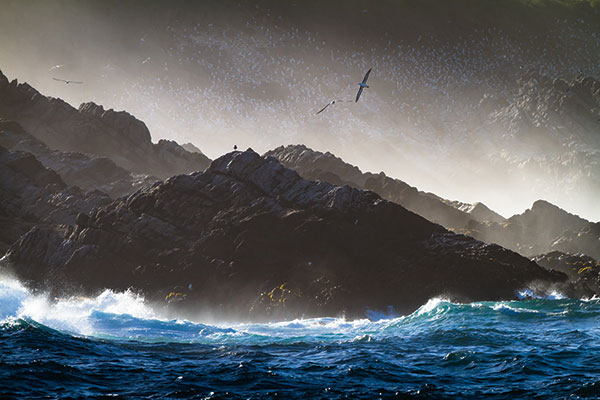
Don’t Leave Home Without Them!
When it comes to landscape photography, telephoto lenses are often forgotten. They slip to the bottom of packs, or are simply left at home. Your bag or closet are bad places for telephotos. They should be accessible, ready to help you see your landscape in a new and creativity-inspiring way. Pull it out, click it onto your camera, and explore the way the lens changes your perspective.
(David Shaw is a professional conservation photographer, writer, biologist, and wilderness guide. He makes his home in Fairbanks, Alaska, but travels widely to photograph and lead others into wild and remote landscapes. Find out more about Shaw, his workshops and tours at www.wildimagephoto.com.)
- Log in or register to post comments






